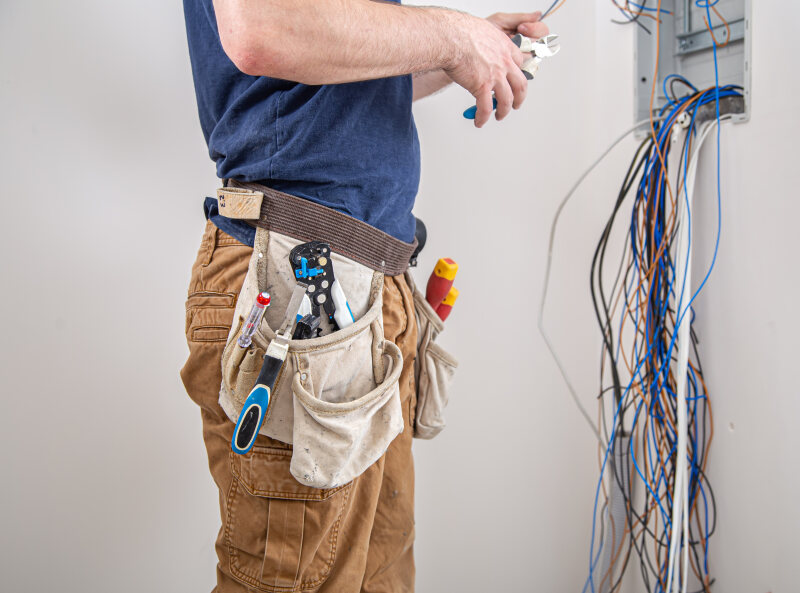Do you give due importance to safety regulations in your projects? Electrical installations stand as a crucial component in this regard!
Yet, amidst the hustle of project execution, the risks stemming from improper electrical wiring installations often loom large, potentially compromising the integrity of your projects and the safety of your clients.
Today, we brought you an article with indispensable insights and important tips to fortify the safety measures within the electrical wiring installations in your projects.
In this text, you will find how to:
- Understand Electrical Safety
- Plan Your Electrical Installation
- Choose the Right Equipment and Materials
Understanding Electrical Safety
In construction, electrical safety isn’t just a priority; it’s a requirement. It encompasses various practices and precautions designed to safeguard clients, teams, and assets.
To provide protection in your projects, it’s crucial to understand what electrical safety truly means.
It goes beyond simply avoiding shocks or fires. It’s about:
- Meticulous planning
- Proper installation
- Ongoing maintenance
- Identifying potential risks before they manifest
- Implementing measures to mitigate these risks
The Risks of Electrical Safety Issues
1. Electrical Shocks:
Electrical shocks are a severe risk on construction sites. Even low-voltage shocks can cause muscle contractions, involuntary movements, and, in some cases, serious injuries.
High-voltage shocks can result in cardiac arrest, burns, and even fatalities. Workers and anyone else on-site face the risk of receiving electrical shocks if proper safety measures are not implemented.
2. Fire Hazards:
According to the U.S. Fire Administration, faulty electrical systems are the leading cause of fires in residential projects. Electrical fires can spread rapidly, engulfing the entire structure within minutes.
These fires are a threat to the safety of workers and occupants, which could lead to extensive property damage and financial losses. Wiring issues, overloaded circuits, and improper installation are common culprits behind electrical fires.
3. Legal and Regulatory Compliance:
Failure to adhere to electrical safety regulations and standards can have legal ramifications.
Regulatory bodies impose strict requirements for electrical wiring installations to ensure the safety of workers and occupants. Non-compliance can result in fines, penalties, and even legal action against the responsible parties.
4. Reputation and Client Trust:
Clients expect construction projects to be completed safely and efficiently, and any lapses in electrical safety reflect poorly on the professionalism and competency of the construction team.
Accidents or safety violations leading to negative publicity can harm client relationships and deter future business opportunities.
To avoid these problems, it is crucial to plan carefully your project’s electrical wiring installation!
Planning Your Electrical Installation

This step is essential before diving into electrical work on your projects, as it sets the foundation for a safe and successful installation process.
Every detail of your electrical layout requires careful consideration to ensure compatibility, efficiency, and, above all, safety. Jumping into the installation without proper planning could lead to costly mistakes and potential dangers later on.
Consulting with professionals is non-negotiable. Experienced electricians can provide invaluable insights and guidance tailored to your project needs. They can:
- Help navigate complex electrical requirements
- Recommend the most suitable equipment and materials
- Ensure compliance with relevant codes and regulations.
Securing the necessary permits is a critical step that demands attention. Building codes and regulations differ depending on the location, and neglecting to obtain the required permits can lead to expensive fines and delays.
TIP:
Working with professionals can streamline the permit acquisition process and guarantee that your electrical installation fully complies with legal requirements.
When creating a detailed electrical layout, attention to detail is key. Consider factors such as:
- Placement of outlets
- Switches
- Fixtures
- Routing of wiring and cables
- Proximity to water sources or combustible materials.
By dedicating time and effort to comprehensive planning, seeking professional guidance, and securing required permits, you establish the foundation for a successful and safe electrical installation process.
Now, onto the next step!
Choosing the Right Equipment and Materials

Regarding the safety of electrical installations for your projects, the quality of equipment and materials you choose can make all the difference. Here’s why:
Opting for inferior products may save money in the short term, but it can lead to frequent malfunctions, premature failures, and potential safety hazards in the long run. High-quality electrical equipment and materials ensure reliability, durability, and, most importantly, safety.
Selecting the appropriate wires, outlets, switches, and fixtures is essential for the success of your project. To determine the best options for your specific needs, consider factors such as:
- Voltage rating
- Current capacity
- Environmental conditions
Remember that consulting with electrical professionals can provide invaluable insights and recommendations tailored to your project requirements!
Whether you are searching for tips for your project, or looking for electrical wiring and other solutions near you, we hope this content has been helpful to you!
Follow us on our social media to see our projects:INSTAGRAM
